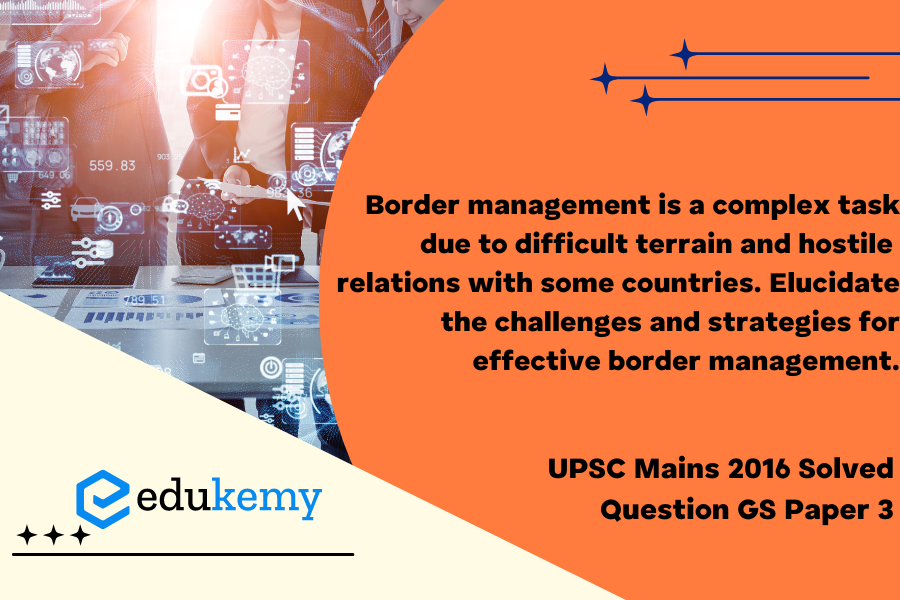Border management presents a multifaceted challenge that is inherently complex, primarily attributed to the intricate interplay of difficult terrains and strained diplomatic relations with certain neighboring countries. The geographical diversity along borders often includes rugged landscapes, dense forests, and vast deserts, making surveillance and control arduous tasks. Moreover, the presence of natural obstacles such as rivers and mountains further complicates the implementation of effective border management strategies. Additionally, the complexity is exacerbated by geopolitical tensions and hostile relationships with neighboring nations, which demand a delicate balance between security imperatives and diplomatic considerations. The challenges encompass a wide spectrum, ranging from the prevention of illegal cross-border activities, including smuggling and human trafficking, to addressing the potential threat of transnational terrorism. To tackle these challenges, strategies for effective border management need to be comprehensive and adaptive. Investments in advanced surveillance technologies, such as drones, sensors, and satellite imagery, can enhance situational awareness and enable proactive responses. Collaborative efforts with neighboring countries are pivotal, emphasizing information sharing, joint patrolling, and coordinated response mechanisms. Furthermore, the development of robust legal frameworks, efficient border infrastructure, and well-trained personnel is essential. Striking the right balance between security imperatives and diplomatic engagement is crucial to ensure that border management not only addresses security concerns but also contributes to fostering regional stability and cooperation.
Tag: Security challenges and their management in border areas- linkages with organized crime with terrorism.
Contents
Decoding the Question:
- In Intro, try to start with general information of India’s bounders and related facts.
- In Body,
- Discuss how border management is difficult task due to hostile neighbours and difficult terrain.
- Discuss various strategies for effective border management.
- Try to conclude your answer as per the context.
Answer:
India has a very large and complex border covering around 15106.7km, which it shares with Bangladesh, China, Pakistan, Nepal, Myanmar, Bhutan as well as a small portion with Afghanistan. The India-Bangladesh border is India’s longest international border measuring 4,096.7 km passing through West Bengal, Assam, Meghalaya, Tripura and Mizoram. India has one of the longest and most varied international borders. Historical political reasons have left India with an artificial unnatural border.

Challenges with respect to border management:
- Difficult Terrain: India-China Border is composed of difficult Himalayan terrain consisting of peaks and heights of more than 6000 M. In such rough terrain of mountainous tracks, fast flowing rivers etc. it becomes very difficult to patrol borders.
- Harsh climatic Condition: Climatic conditions on the North, West and North-eastern border are extreme. In such extreme weather, continuous watch and oversight is problematic.
- Porous nature of border: India’s land border with Pakistan in Himalayan region, Myanmar in north eastern hills, and with Bangladesh is porous with nullah, fast-flowing rivers etc. These are often used by infiltrators and smugglers.
- Undefined borders: Undefined and unfenced border with China and Pakistan in north western part and with Myanmar in north eastern part is another challenge. It gives insurgent groups, arm dealers, drug smugglers, and human traffickers safe traveling options across the border.
- Maritime border issues: Especially in the west coast, there is always the possibility of infiltration of terrorists in ferryboats/fishermen boats as happened in case Mumbai Attack 2008.
- Poor technology usage: India’s borders are porous, difficult terrain, jungles, hostile neighbors etc. made border guarding very difficult task but usage of modern technologies like drones which can be very useful in border management and keeping 24 into 7 vigilance
- Stress among existing personnel: Border forces also suffer from long hours of duty and long-stay away from home, substandard behavior of officers towards their juniors etc. These issues affect the morale of security personnel which ultimately affect border guarding.
Strategies for effective border management:
- 24x7x365 day surveillance along the Indo-Pak border with a 5 layer smart fence.
- Agreement on basic guiding principles and standard operating procedures.
- Increasing confidence building measures and communication linkages to avoid unnecessary confrontation and escalation Integrated border management by involving and enhancing cooperation with counterparts of neighboring countries especially along open borders.
- Effective implementation of the recommendations of One Border One Force by the Task Force on Border Management to weed out inter agency frictions.
- Increase the role of stakeholders, community measures and awareness can be deployed along open borders to prevent illegal activities.
- Implementation of Border Area Development Programme and other developmental initiatives so that there is no feeling of being left out.
- Improved coordination and intelligence sharing with neighboring countries: Coordination with neighboring countries would help in monitoring cross border illegal migration, arms and drugs smuggling etc. Such an initiative can be taken with friendly countries like Bangladesh and Sri Lanka.
- Improved maritime patrolling and use of technology to identify intruding boats.
India’s border expanse is very diverse and manning it is a difficult task. India has been facing a number of challenges due to inefficient border management, but it is high time, especially in light of recent tensions and violence, that the entire security gamut and border management infrastructure be revisited and made more effective.
In case you still have your doubts, contact us on 9811333901.
For UPSC Prelims Resources, Click here
For Daily Updates and Study Material:
Join our Telegram Channel – Edukemy for IAS
- 1. Learn through Videos – here
- 2. Be Exam Ready by Practicing Daily MCQs – here
- 3. Daily Newsletter – Get all your Current Affairs Covered – here
- 4. Mains Answer Writing Practice – here


